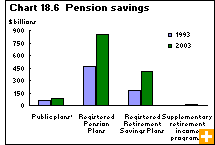Common menu bar links
Our growing nest eggs
Archived Content
Information identified as archived is provided for reference, research or recordkeeping purposes. It is not subject to the Government of Canada Web Standards and has not been altered or updated since it was archived. Please contact us to request a format other than those available.
Canadians’ assets in registered pension plans (RPPs), registered retirement savings plans (RRSPs) and the Canada/Quebec Pension Plans (C/QPP) have doubled in value since 1990 (taking inflation into account). By 2003, Canadians had more than $1.3 trillion saved in these accounts for their senior years.
RPPs account for the biggest chunk of this total, at about 63%. These plans are established by companies to provide pension benefits for their employees when they retire. RRSPs account for 30%. They are personal retirement savings plans offered by financial institutions. The government-run C/QPP retirement plans account for about 6%.
Pension funds are heavily invested in stocks and equity investment funds, so the strong performance of the stock market over the 1990s was a major factor driving their growth. Weaker market conditions in the first years of the new century have made it difficult for RPPs and RRSPs to regain the levels they reached in 2000. But over the longer term, the growth has been strong.
As of January 2004, there were 14,777 active registered pension plans in Canada, covering 5.6 million working Canadians. The share of people covered by an RPP, however, has been shrinking over the past three decades, from 46% in 1977 to 39% in 2003.
In addition to RPPs, Canadians can turn to other retirement savings programs, such as RRSPs. In 2004, about 5.6 million Canadians—or about 38% of all eligible taxfilers aged 25 to 64—made RRSP contributions with a value of $25.2 billion. This proportion was up slightly from 36% in 1992. In 2004, 1.4 million Canadians withdrew about $7 billion from their RRSP accounts—an average of $4,905 per person.



